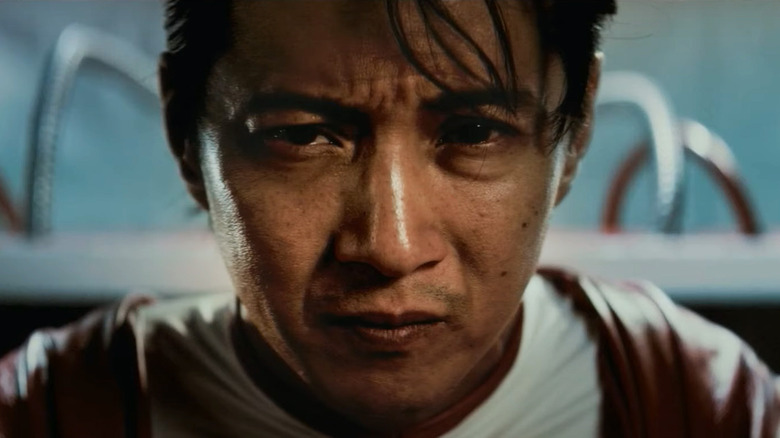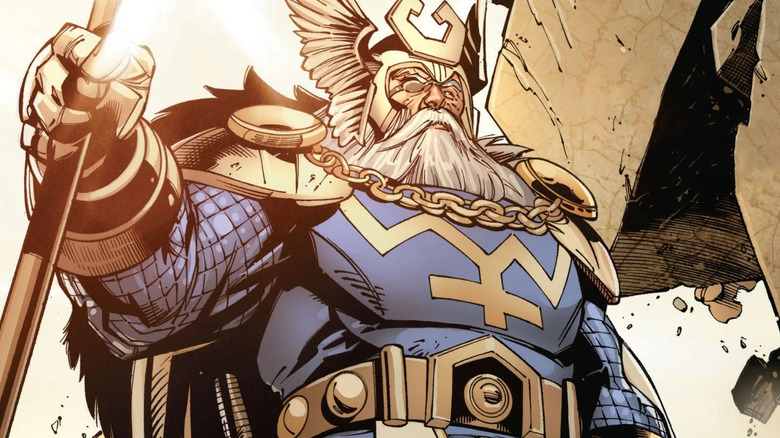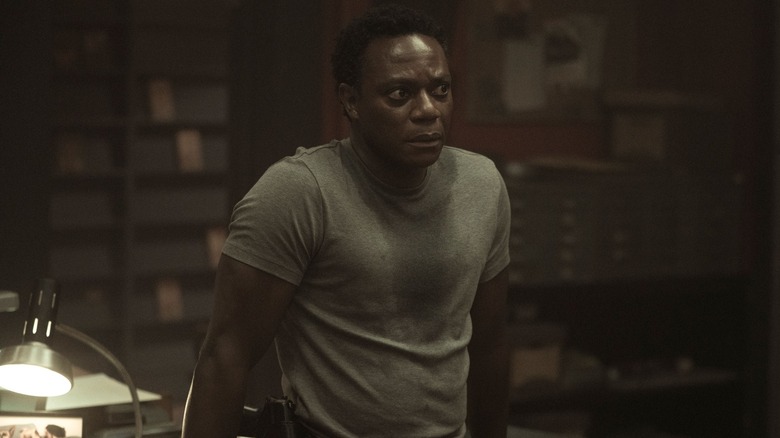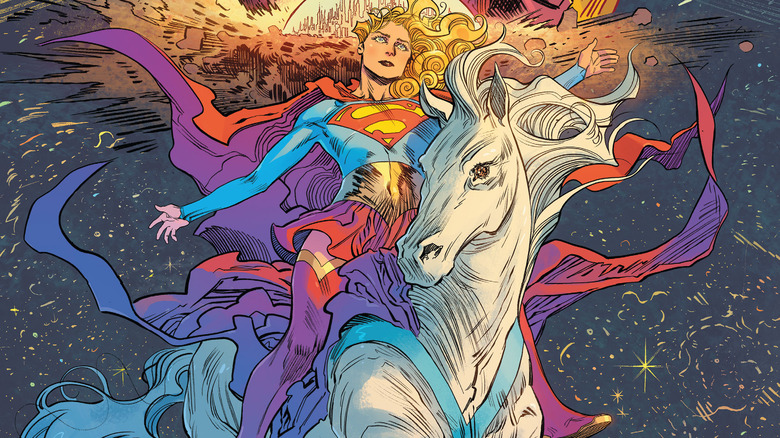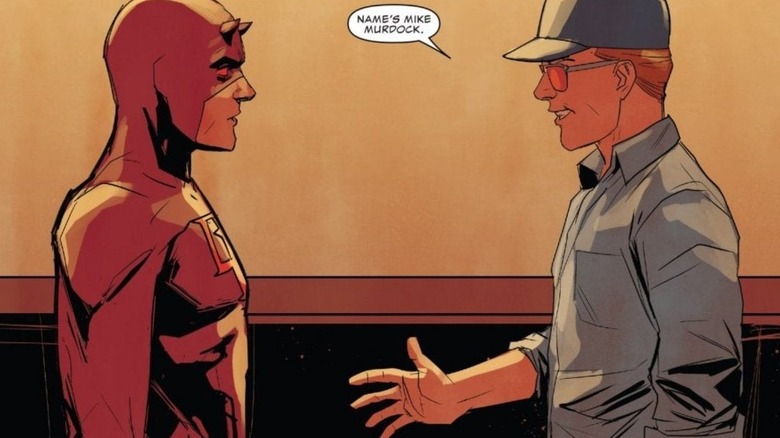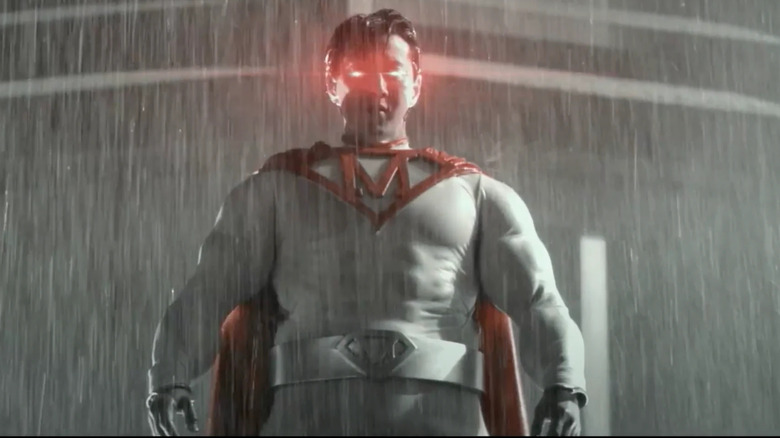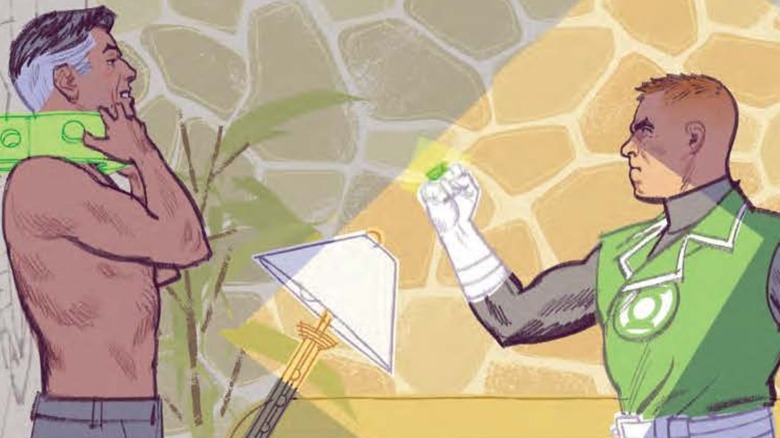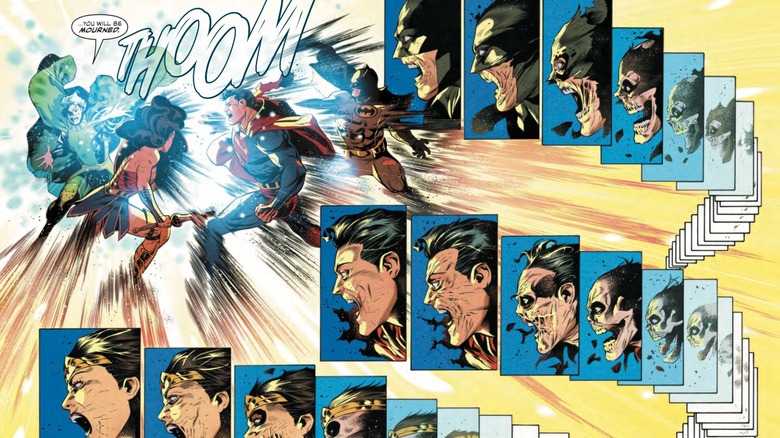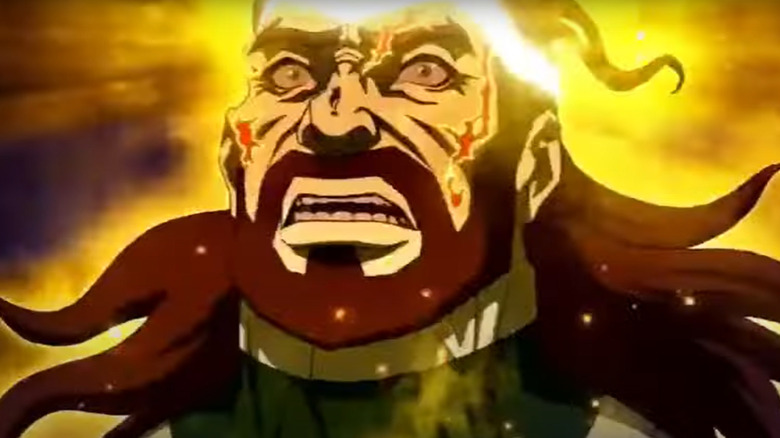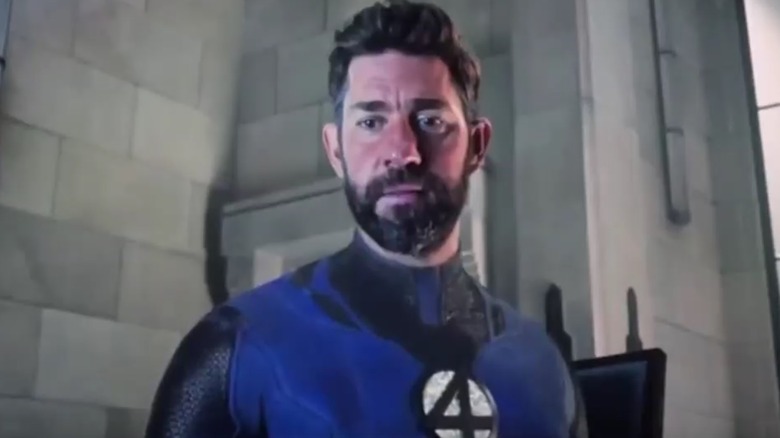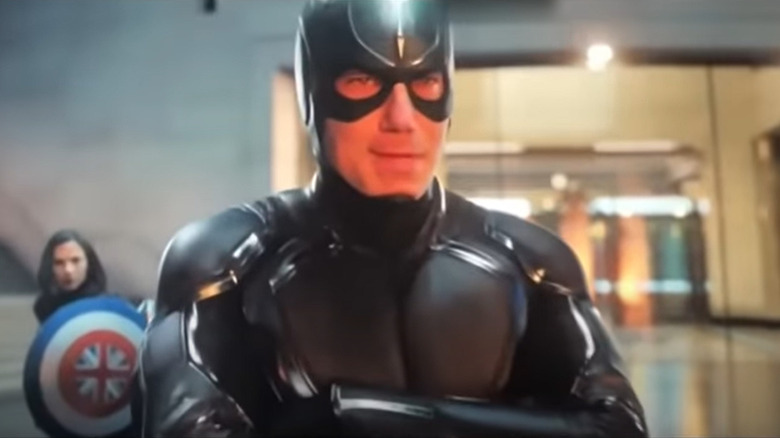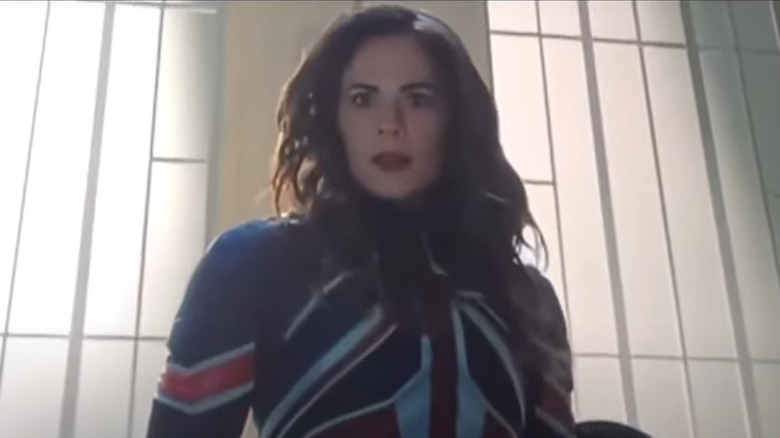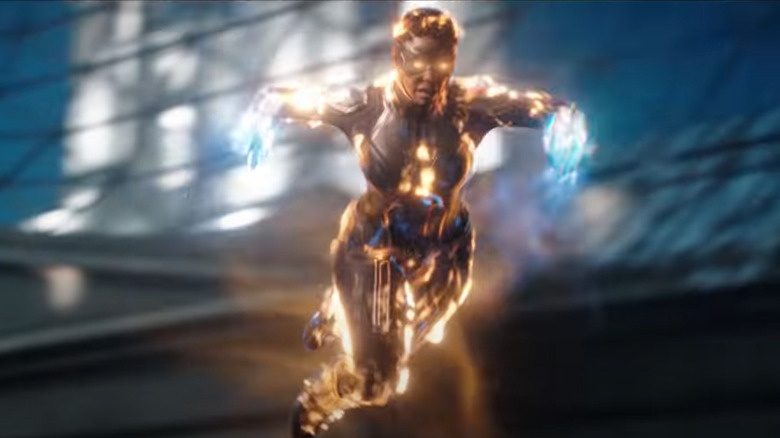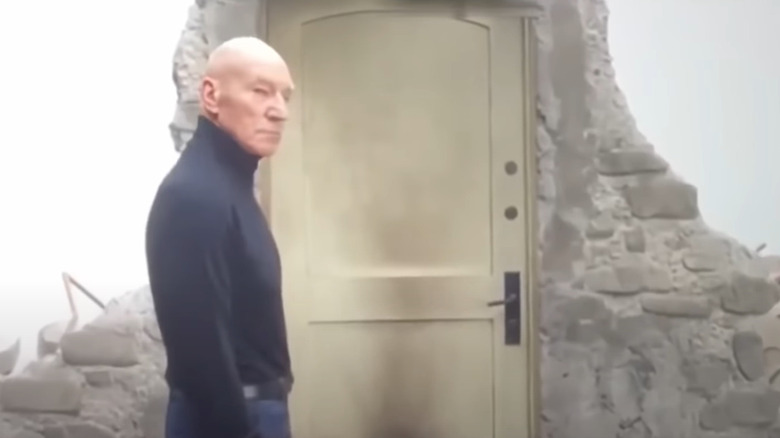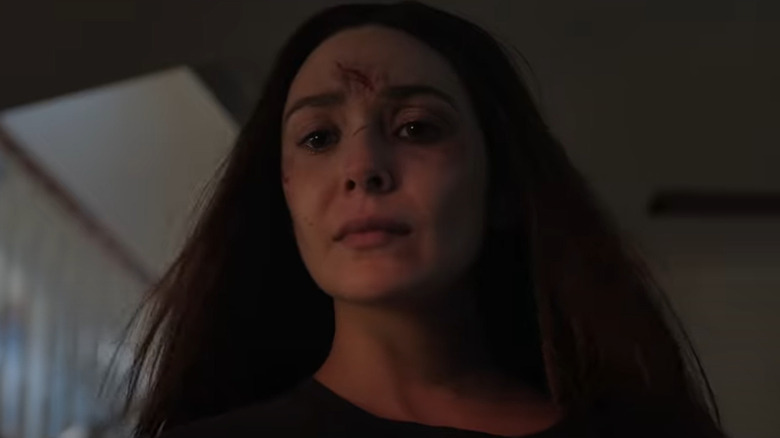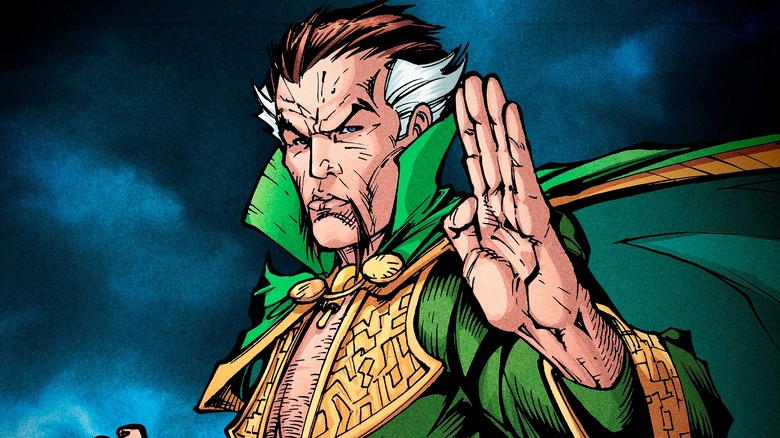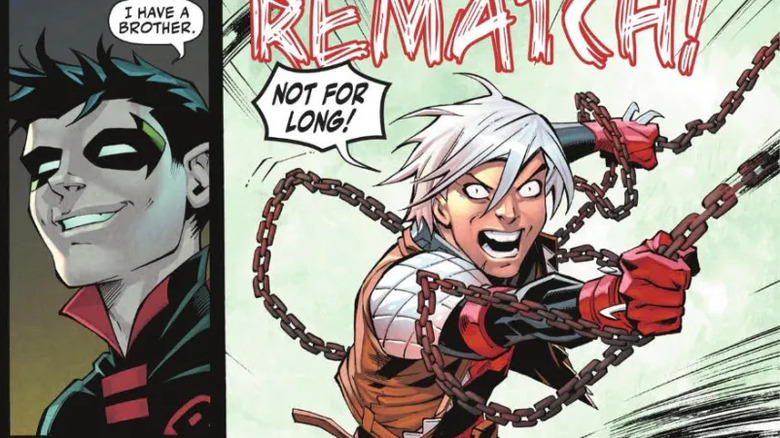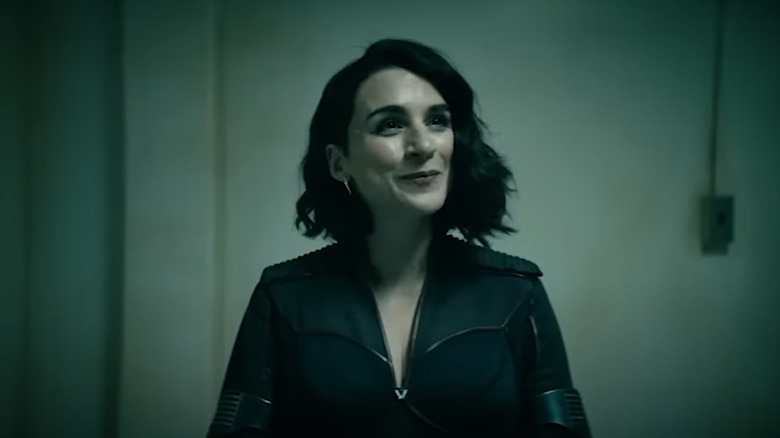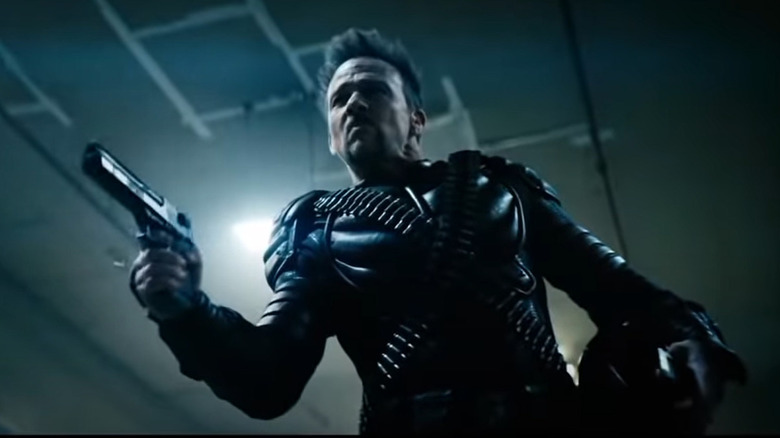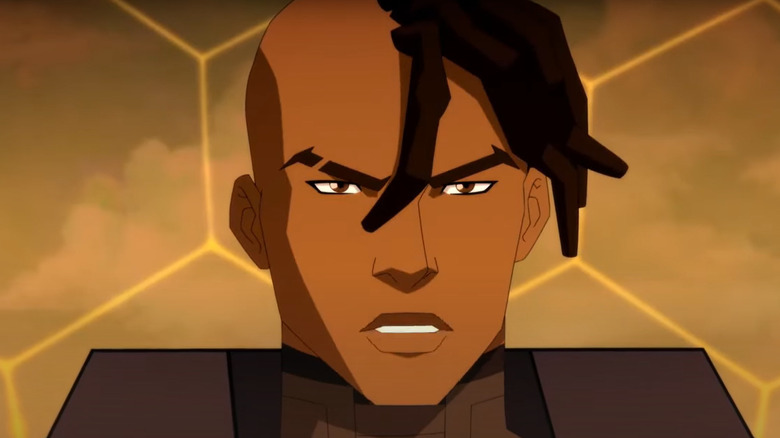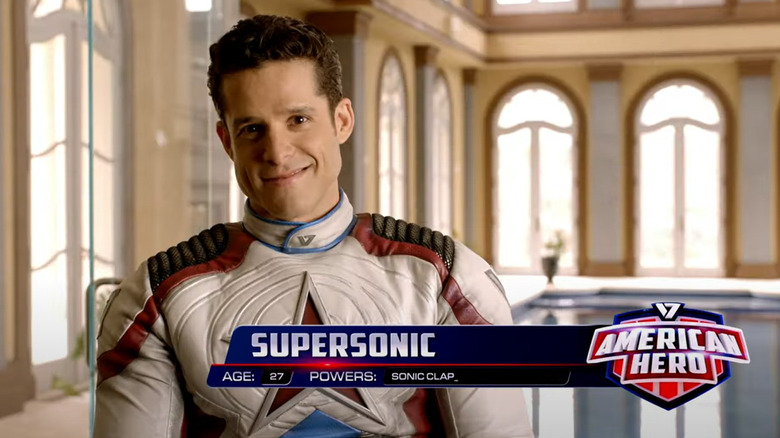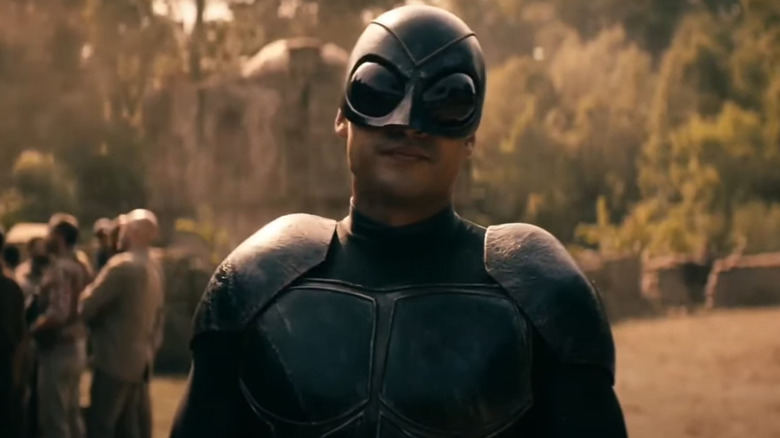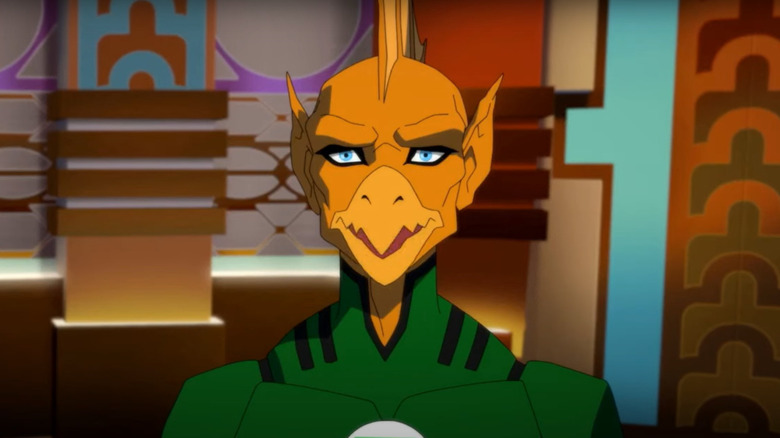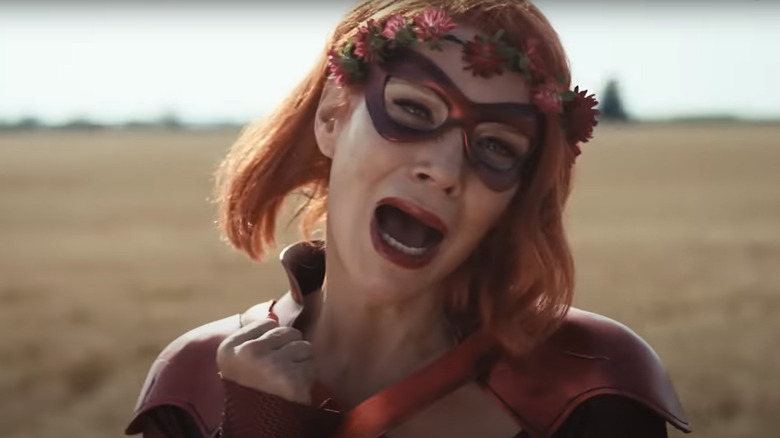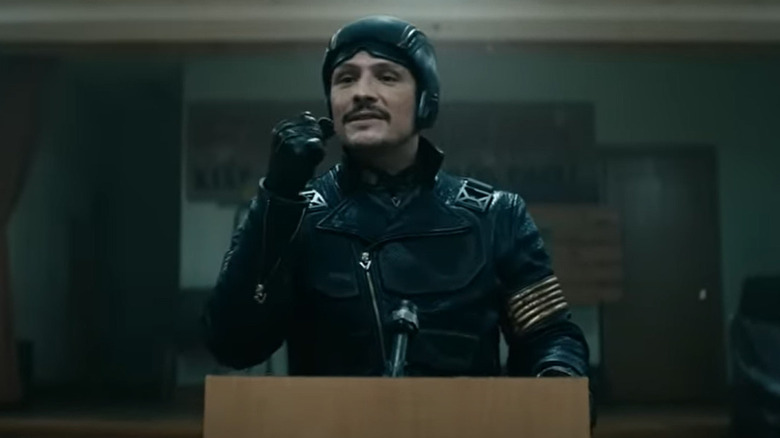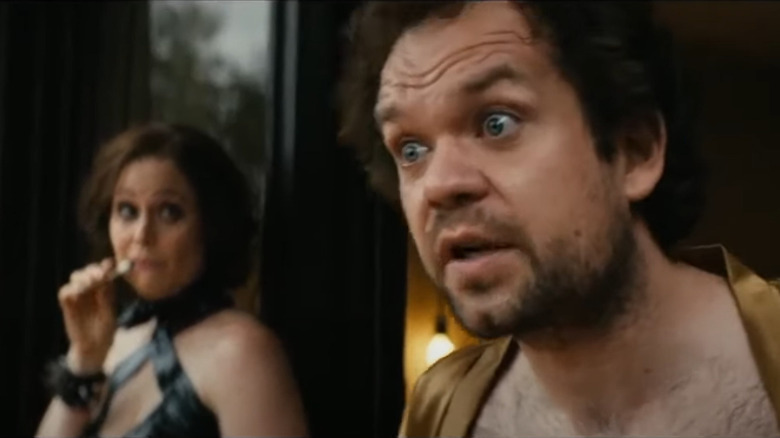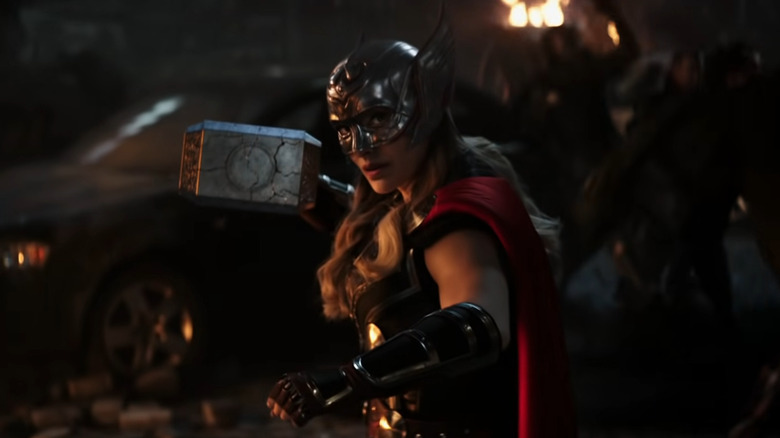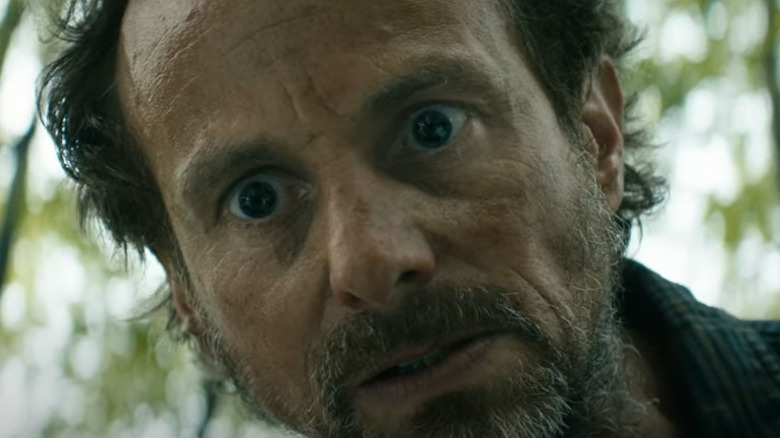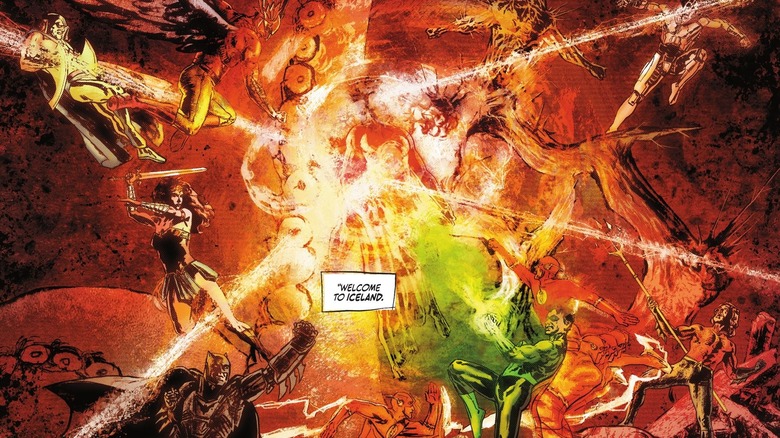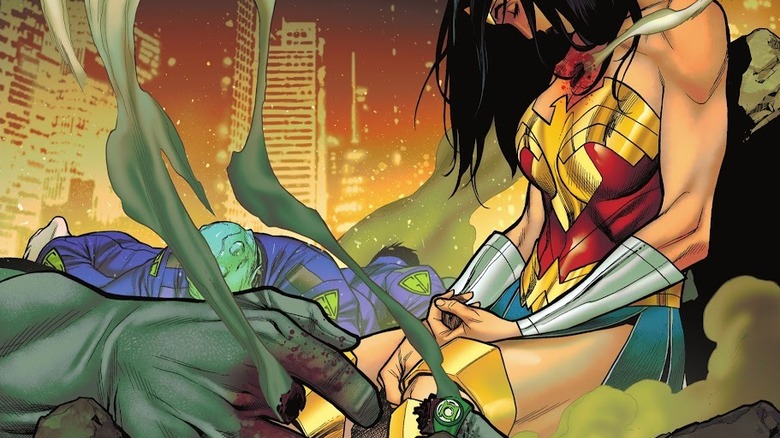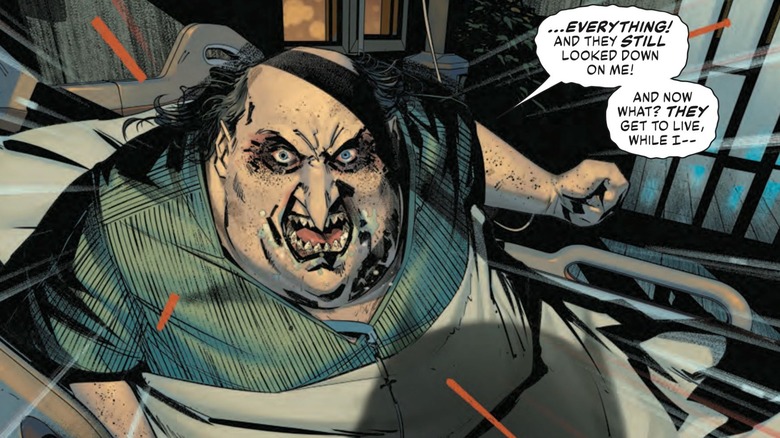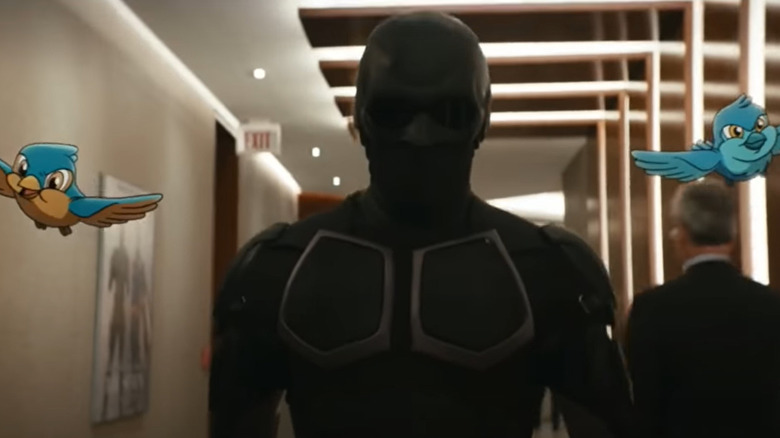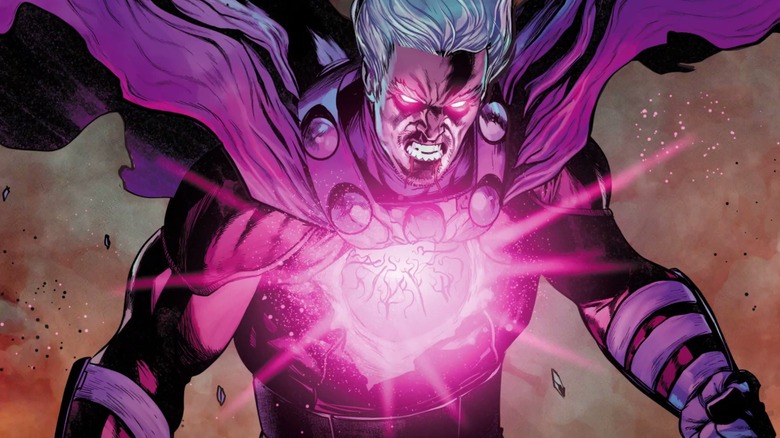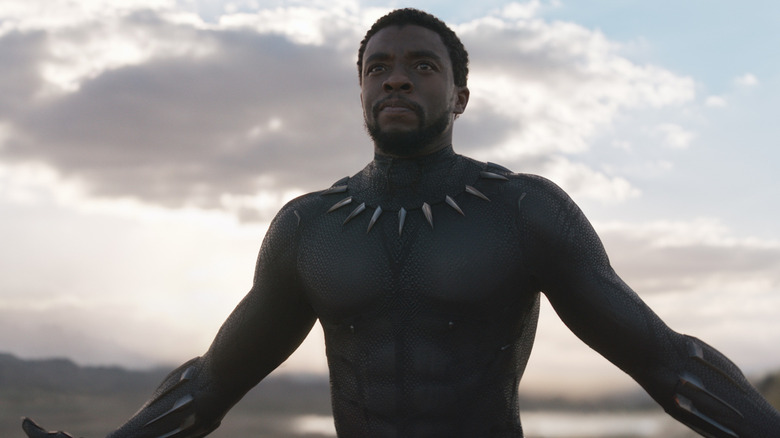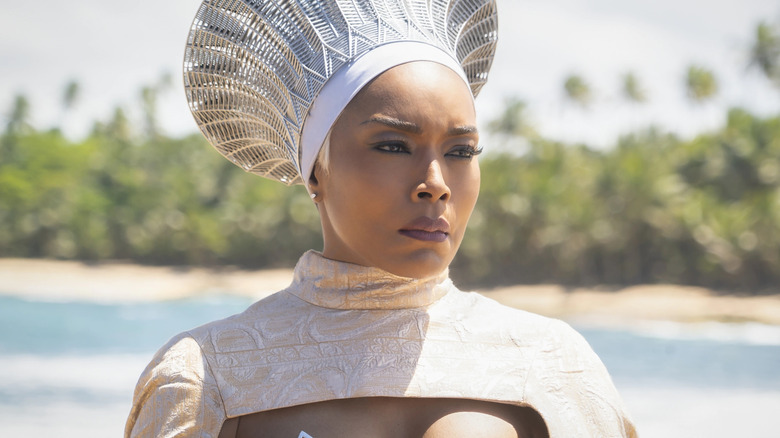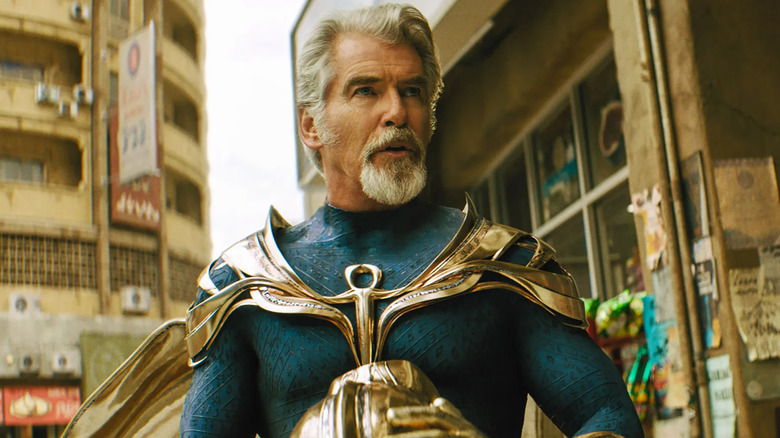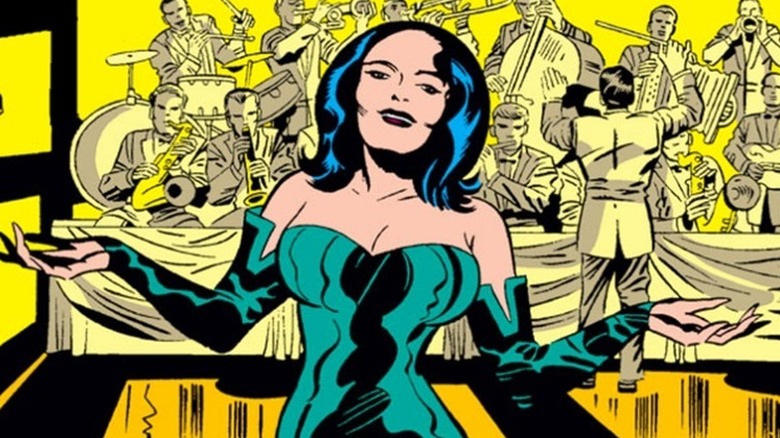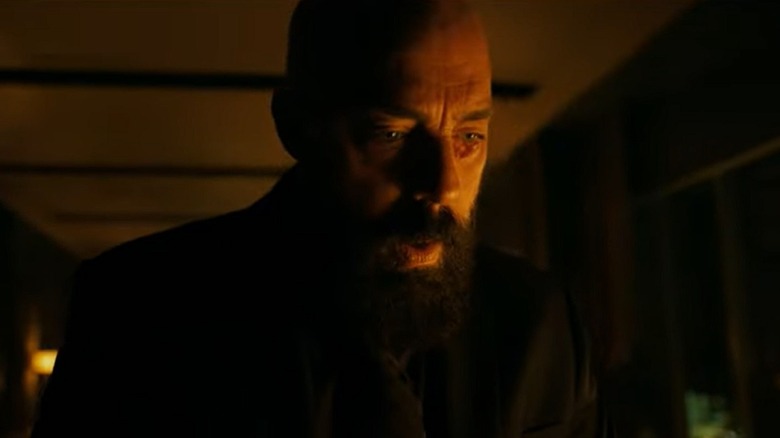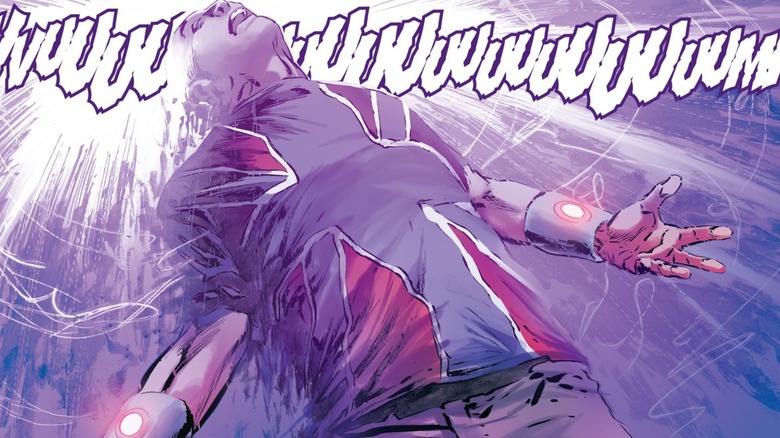Superheroes We Lost In 2022
Once upon a time, superheroes were functionally immortal. No writer would dare kill off a potentially profitable intellectual property ... until 1980's "The Dark Phoenix Saga" and 1993's "The Death of Superman" came along. Or, more precisely, until the characters killed in these storylines were resurrected. After Jean Grey and Clark Kent proved death needn't last forever, the days of de facto invulnerability for every cape-clad crimefighter were over.
Nowadays, superheroes die like flies. Sometimes they die to give monthly sales a quick shot in the arm, sometimes they die for the sake of a shocking plot twist, and every once in a while, they die to bittersweetly close out an era of blockbuster cinema. The good news is, superheroes can also come back from the dead at any time, for essentially all the same reasons.
What follows is an attempt to chronicle all the superheroes or superhero-adjacent characters across comics, television, and film whose time upon this mortal coil came to a close in stories published or released in 2022. Let us now solemnly mourn these avatars of justice and might with whom we have parted ways ...for the time being, at least.
Updated on January 4, 2023: Like any year, 2022 saw many superheroes take their final breath, and this list reflects all the do-gooders who fell in the line of duty.
Odin
Not unlike his baby boys Thor and Loki, Odin appears in Marvel comics, DC comics, various works of fantasy, and, of course, Norse mythology. MCU viewers associate the All-Father with Anthony Hopkins' portrayal in 2011's "Thor," 2013's "Thor: The Dark World," and 2017's "Thor: Ragnarok." As is the case with Asgard itself, Marvel's Odin goes through cycles of destruction and rebirth. He dematerializes into particles of bright light at the beginning of "Thor: Ragnarok," and similarly wills himself out of existence at the conclusion of 2022's "Thor" #22, by writer Donny Cates and artist Nic Klein.
In this penultimate installment of Cates' "God of Hammers" arc, Odin reveals that his continued existence is preventing Thor, the current king of Asgard, from wielding the full cosmic might usually at the disposal of his royal station. Recognizing that Thor needs an extra boost to defeat the renegade God of Hammers — a blend of Mjolnir's energy and the nefarious Mangog — Odin releases the last of his power to his son, erasing himself in the process.
We should note that the conclusion of "Thor" #23 indicates the nature of Odin's death may be a matter of relativity. Regardless, for all practical intents and purposes, the old man is enjoying a permanent vacation in Valhalla.
Clemson Murn
In 2016's "Suicide Squad," only two members of Task Force X bite the big one. In contrast, 2021's "The Suicide Squad" includes a wholesale massacre of DC C-list baddies. Happily, this slaughter does not include Peacemaker (John Cena), allowing him to return for his HBO Max series.
Perhaps in the interest of consistency with the film, "Peacemaker" ends Season 1 with fewer characters than it starts. Most of these characters are ordinary humans or members of the hostile alien race colloquially known as butterflies. The butterfly Ik Nobe Llok, who inhabits the body of ex-mercenary Clemson Murn (Chukwudi Iwuji), is sort of both. And in many respects, his ultimately self-sacrificing quest to prevent his fellow butterflies from annihilating the human race qualifies as super-heroic.
After the butterflies take over the police force of Evergreen, Washington, Murn/Ik Nobe throws himself under the metaphorical bus to allow Harcourt (Jennifer Holland) and Adebayo (Danielle Brooks) to evade execution and carry on with their mission. In a tragic twist, the butterfly Eek Stack Ik Ik — sometimes referred to as "Goff" and inhabiting the body of Detective Sophie Song (Annie Chang) — happens to be the individual who repeatedly pulls the trigger on Murn.
Comet the Super-Horse
We haven't seen a ton of super-pets since 1985's "Crisis on Infinite Earths" reset the DC universe's timeline and removed them from officially-recognized existence. So it's nice to see Krypto the Superdog and Comet the Super-Horse make something of a comeback in 2021's "Supergirl: Woman of Tomorrow."
Tom King and Bilquis Evely's eight-issue epic — one of the best comics of 2021, in our estimation — sends Kara Zor-El on a galaxy-spanning journey. She's determined to track down Krem, an interstellar pirate who needlessly slew her friend's father, then poisoned Krypto while making his escape. By the time the final issue arrives, Supergirl has successfully detained Krem. However, Krem manages to send for a cavalry of space pirates to help reverse his fortune. After a significant struggle, Supergirl manages to dispatch these baddies, but Comet loses his life in the process.
It's a little ambiguous whether "Supergirl: Woman of Tomorrow" is a canonical tale, so this Comet's precise nature is difficult to pin down. But Supergirl does mention that she knew he was a man cursed to live as a horse — a fact he didn't love talking about. This death might not stick, but it's still enormously moving.
Mike Murdock
This one lands squarely in the "superhero-adjacent" category. Mike Murdock is the twin brother of Matt Murdock, the occasionally secret identity of the crimson crime-slapper, Daredevil. As Mike Murdock points out in 2022's "Devil's Reign #5," he technically doesn't exist. Initially, Matt Murdock uses the phony persona of his imaginary twin brother Mike to throw off folks who've come a little too close to figuring out his secret identity. Later, due to circumstances involving the Inhumans and a reality-warping Norn Stone, Mike Murdock goes from being an idea of a person to a tangible person, and inserts himself into the canonical Marvel timeline.
Basically, Mike is a fake person with a past that never happened, but he's the only one who knows that. By the time "Devil's Reign" — a miniseries by Chip Zdarsky and Marco Checchetto — rolls around, Mike Murdock is a fairly high-ranking affiliate of organized crime in Hell Kitchen. Also, at his brother's request, he frequently pretends to be Matt while Matt's off doing Daredevil-related business. In "Devil's Reign #5," he happens to be disguised as Matt in Matt's apartment, right around the time Wilson Fisk regains his memory of Matt's secret identity and decides to extract lethal revenge. Lacking his brother's ninja skills or hyper-alert senses, Mike is swiftly beaten to death and returns to his natural state of nonexistence.
Marvelous Man
Netflix threw its hat into the superhero satire ring with 2022's "The Guardians of Justice." Reminiscent of "The Boys," "Invincible," and HBO's "Watchmen," "The Guardians of Justice" doesn't treat the cape-and-cowl set as spotless heroes. Marvelous Man (Will Yun Lee), this universe's ersatz Superman, seemingly dies on live television, but some of his colleagues suspect foul play. Much like Rorschach's search for the Comedian's killer kicks off "Watchmen," "The Guardians of Justice" joins Knight Hawk (Diamond Dallas Page) as he explores the mystery of Marvelous Man's death.
But who is Marvelous Man? He arrived on Earth after his home planet was destroyed by the "Guardians of Justice" stand-in for Brainiac. Like any wannabe Superman worth his salt, Marvelous Man can fly, has heat vision, boasts seemingly impossible strength, and is virtually invulnerable to all potential harm, except for this world's Kryptonite equivalent. The copyright-safe version of a Kryptonite bullet which kills him is ostensibly stolen from the stand-in for Lex Luthor. Sound bizarre? It is. But that's how "The Guardians of Justice" rolls.
Guy Gardner
In 2022's "The Human Target," private investigator Christopher Chance, aka the Human Target, ingests a slow-acting poison intended for Lex Luthor. He has 12 days to figure out who's to blame for his rapidly approaching death, and the hardboiled gumshoe suspects the involvement of at least one member of Justice League International. The ensuing tale blends elements of noir detective traditions and the irreverent side of DC publishing that emerged in the late 1980s and early 1990s.
Whether or not Tom King and Greg Smallwood's miniseries takes place in the mainstream DC timeline is unclear. Therefore, Guy Gardner may appear in another, more canonical story before the end of the year, or even reemerge somehow in "The Human Target." Nevertheless, the fact remains that the Green Lantern Corps' biggest jerk is evidently killed in a fight with Ice, his ex, and Chris Chance in "The Human Target" #6.
Originally one of Christopher's suspects, subzero superheroine Ice eventually becomes his romantic interest, much to Guy's jealous fury. The third-most famous Green Lantern attacks the new couple after a night of passion, only to find himself frozen solid and shattered to pieces, in that order. Let that be a lesson to awful exes everywhere — nothing good ever comes from stalking and harassment, even if you have a power ring from space.
The Justice League
Plenty of folks who'd like to get into superhero comics find themselves stymied by DC and Marvel's convoluted continuity, jarring reboots, and reliance upon obscure characters with omnipotent powers appearing from out of nowhere. They've got a new hurdle to clear, courtesy of "Justice League #75" by Joshua Williamson and Rafa Sandoval: In this issue, a previously benevolent dimensional traveler named Pariah effortlessly dematerializes a sizeable fraction of DC's best-known, usually-unstoppable champions of virtue. Specifically, Pariah kills the Justice League — Superman, Batman, Wonder Woman, Green Lantern, Zatanna, Aquaman, Hawkgirl, and the Martain Manhunter. He also bumps off multidimensional Justice Leaguers including President Superman of Earth-23, Doctor Multiverse of Earth-8, Captain Carrot of Earth-23, and a handful of others. Promotional materials tell us this ghastly, traumatizing massacre of globally beloved characters leads into DC's summer of 2022 event, "Dark Crisis."
All of this is plenty shocking by itself, but here's the kicker — current "Action Comics" scribe Phillip Kennedy Johnson has already made it known, via an interview with CBR, that Superman's death will in no way interrupt Kal-El's noble struggle against intergalactic tyranny and oppression in his concurrent "Warworld Saga." Likewise, ceasing to exist doesn't seem to be stopping Batman from hunting Ra's al Ghul's assassin in the "Shadow War" multi-series crossover. DC's most prominent heroes have died in "Justice League." Somehow, they all continue to prosper in their solo adventures. What gives? We suppose we'll have to keep reading.
Arion (Ocean Master)
With so many supervillains hatching so many devious plots at all times, you'd think there'd be no original scheme for world domination left untried. The "Young Justice" version of Orm the Ocean Master might be Arthur Curry's answer to Loki with a lot less charisma, but let's give him credit — he attempts what truly seems to be an original evil plan.
Correctly guessing he could charm the people of Atlantis by embodying an imagined glorious past, Ocean Master transplants his consciousness into a clone of Arion, the original leader of the undersea kingdom. As this Atlantean George Washington, Ocean Master wins major battles and makes plenty of inspiring speeches. To cover his bases, he also clones himself and loads that clone up with memories, so only an expert mind reader could sniff out his ruse.
As it happens, the "Young Justice" crew includes prominent telepath M'gann M'orzz, who easily figures out what's up. But by the time M'gann warns the Justice League-adjacent Atlanteans of Ocean Master's presence in Arion's body at the end of Season 4's "Leviathan Wakes," it's too late — "Arion" is declared the new king of Atlantis. Luckily, thanks to an ancient prophecy involving the Lords of Order and Vandal Savage, "Arion" spectacularly explodes the instant he puts the crown on his head.
Reed Richards (Earth-838)
Fans of the Fantastic Four have waited years for Marvel's First Family to take their rightful place at the center of the MCU, and they probably won't have to stay patient for much longer. Even though it's currently in need of a new director, "Marvel's Fantastic Four" should come intro fruition within the not-too-distant future. Hopefully the version of Reed Richards from the mainstream MCU timeline fairs a little better than the Reed who leads the Illuminati from Earth-838 because that guy (John Krasinski) dies a swift, excruciatingly painful, and humiliating death.
In "Doctor Strange in the Multiverse of Madness," the Scarlet Witch chases Strange (Benedict Cumberbatch) and America Chavez (Xochitl Gomez) to Earth-838, hoping to use America's dimension-hopping powers to reunite with her sons. Earth-838's Illuminati — essentially a secretive group of elite superheroes — do not initially take the threat of the Scarlet Witch seriously. If they can beat Thanos, how much of a problem could Wanda Maximoff possibly be, right? As it happens, the Scarlet Witch controls reality itself, so she turns Reed into string cheese and then makes his brains explode. Better luck next time, Tuna.
Black Bolt (Earth-838)
At this point, the Inhumans are basically the inverse of the Guardians of the Galaxy, where the prominence of superheroes in live-action media has actually hurt the prestige and credibility the characters enjoyed in the Marvel Universe back when there was no serious possibility that they'd have to function in other forms of media. The Inhumans TV show is the biggest abject failure in MCU history, and there is not a close second. The X-Men's movie rights returning to Marvel pretty much destroys any remaining chance of the Inhumans occupying the MCU's lane for genetically gifted outcasts. And Black Bolt (Anson Mount) probably died the most gruesome and unsettling demise of any Illuminati member in "Multiverse of Madness," which is saying something.
After Reed Richards of Earth-838 informs Wanda that Black Bolt can annihilate her with a whisper, Wanda replies, "What mouth?" The king of the Inhumans then notices that his mouth has vanished. He panics, and the resulting yelp causes his skull to pop like a blister. We don't think the mainstream MCU timeline's Black Bolt, also played by Mount, would ever be dumb enough to use his unfathomably destructive vocal cords while his mouth was sewn shut. He might be a commercial failure, but the Black Bolt of the ABC television network is probably way harder to kill than this guy.
Captain Carter (Earth-838)
Since arriving on the scene in 2011's "Captain America: The First Avenger," Peggy Carter (Hayley Atwell) has journeyed from movies to network television to streaming animation. While anyone who watched ABC's "Agent Carter" can attest to the combat prowess of the the version of Peggy who resides in the regular MCU timeline, the Peggy variant from "What if... Captain Carter Were the First Avenger?" would probably be more useful in a fight against Dr. Doom.
The Disney+ series "What If...?" tells us the tale of Captain Carter, a time displaced World War II-era hero who's injected with the super soldier-serum when the original test subject, Steve Rogers, is made temporarily unavailable. However, we can safely presume the events of "What If...?" are not directly connected to conditions on Earth-838. Captain Carter is slated for significant amounts of screen time in "What If...?" Season 2, and the Earth-838 variant of Peggy is all out of time, screen-related or otherwise.
Relative to the other Illuminati members, Captain Carter puts up a decent fight against the Scarlet Witch. She even manages to land a few strikes before Wanda takes telepathic control of Captain Carter's signature shield and uses it to separate Peggy's lower half from the rest of her torso. By the way, is Earth-838's Captain Carter using the Rocketeer's old jetpack? Because she flies around on a jetpack that definitely looks like the sort of thing we'd typically see strapped to the back of Cliff Secord.
Captain Marvel (Earth-838)
In the primary MCU timeline, Maria Rambeau (Lashana Lynch) is Carol Danvers' friend, the mother of Monica Rambeau (Teyonah Parris), and passes away during the years between "Infinity War" and "Endgame." In Earth-838, evidently Maria became Captain Marvel instead of Carol Danvers, and she went on to join Reed Richards' Illuminati. Sharing the attitude of the rest of her pompous secret society, Maria tells Strange they "can handle your little witch" if Wanda Maximoff shows up looking for America Chavez.
As it turns out, Earth-838's Captain Marvel can not, in fact, handle the "little witch," who squashes Captain Marvel by dropping a statue on her.
Somewhat curiously, Earth-838 Maria wears a teal-colored costume similar to the uniform Carol Danvers fights in during her time as the amnesiac Kree warrior Vers in 2019's "Captain Marvel." In theory, this could indicate that some sort of diplomatic relationship exists between the Kree and the governments of Earth-838, but who knows if we'll ever hear more about this timeline's history.
Professor X (Earth-838)
Patrick Stewart played Professor Charles Xavier for the first time all the way back in the year 2000's "X-Men" and once said he'd step away from the role after the high note of 2017's "Logan." Apparently, Kevin Feige used mind control abilities of his own — not unlike Jason Wyngarde or, perhaps, the Shadow King — to convince Stewart play Xavier for the eighth time in "Multiverse of Madness." Although, in fairness, since the Earth-838 variant of the benevolent mutant telepath technically isn't the same person we see leading the X-Men in any 20th Century Studios "X-Men" movies, Stewart could somewhat credibly argue that he never went back on his word.
Like the rest of the Illuminati, Earth-838 Professor X finds himself utterly overwhelmed by the Scarlet Witch, who creeps up behind him on the astral plane and snaps his neck like a celery stick. We wish we could've seen more of Professor X in the "Multiverse of Madness," especially after Stewart's authoritative declaration of "we should tell him the truth" was so heavily featured in trailers. And perhaps in another universe, when Professor X's '90s-era floaty chair glides into the frame, the movie would pan back to reveal James McAvoy looking ruminative and wise in a bald cap.
The Scarlet Witch
In 2021's breakout hit series "WandaVision," Wanda Maximoff (Elizabeth Olsen) transcended her status as an ill-defined supporting character in "Avengers" movies and evolved into a morally ambiguous and all-powerful magic wielder. Under the corruptive influence of the Darkhold, Wanda has gone full-on evil in "Multiverse of Madness," only to switch gears in the climax by seeing the error of her ways. As a result, she collapses the Mount Wundagore temple on herself, closing the Darkhold once and for all.
It's possible we've seen the last of Wanda Maximoff in the MCU, but there are a handful of significant caveats we should keep in mind. We only see rubble falling on Wanda's general vicinity. We do not see her corpse, and this is a movie that very much wants us to show us superhero corpses whenever possible. And while many of the Earth-838 variants of familiar characters we meet in "Multiverse of Madness" don't survive the experience, the Earth-838 Wanda Maximoff happens to the end the story alive and well, as far as we know.
Ra's al Ghul
Longtime arch-nemesis to Bruce Wayne and scary grandpa to Damian Wayne, Ra's al Ghul is assassinated at the onset of DC's "Shadow War" event, causing plenty of readers to roll their eyes in completely appropriate incredulity.
Not only does Ra's — the centuries-old one-time leader of the League of Assassins — benefit from the same squishy relationship with mortality that keeps the rest of DC and Marvel's denizens uniquely prone to resurrections, immortality is kind of his whole deal. In the past, when injuries or illness had Ra's skirting the edges of the great beyond, he'd retreat to the Lazarus Pit — a literal fountain of youth — and regenerate his body into that of a younger, healthier megalomaniacal eco-terrorist. Basically, Ra's al Ghul dying and not coming back is kind of like if the Joker stopped doing murders and laughing at ironically morbid circumstances; it just feels wrong even if it's clearly a positive development for the citizens of Gotham City.
But implausible as it seems, at the conclusion of "Shadow War" — a multi-title crossover penned by Joshua Williamson — Ra's al Ghul remains as apparently deceased as he does at the beginning. Damian is still pretty messed up about the death of Alfred Pennyworth, and now he's lost his literal grandfather shortly after his surrogate grandfather. Our dude is having a rough couple of years.
Respawn
When the mercenary forces of Talia al Ghul and Deathstroke throw down in "Shadow War," a lot of them die, including Respawn. The promising young killing machine debuts in the League of Lazarus deathmatch tournament seen in the pages of 2021's "Robin," and he initially appears to have lifted his costume style and gimmick from Deathstroke. But Respawn is much more than a Slade Wilson fanboy. Ra's al Ghul, being an utterly insane scientific genius, mixed genetic material from his daughter Talia and Deathstroke to make the baby they would create in the unlikely scenario of their copulation. Damian is initially psyched to find out he has a half-brother, but his excitement is short lived. Shortly thereafter, Respawn hurls himself in front of a hail of bullets and various other projective weapons intended for Pappa Slade, and as a result, he is ripped to shreds.
Stormfront
Many of us assumed a knife to the eye, the incineration of three of her limbs, and the third-degree burns covering the rest of her body would've put an end to Stormfront at the conclusion of "The Boys" Season 2, which aired back in 2020. When Season 3 starts, it looks like we assumed incorrectly.
Just like the hipster racism that inspired Prime's version of the ageless white supremacist, Stormfront isn't entirely dead — she's merely a heavily disfigured mental and physical husk who can only lie in her own misery and drool while the embodiment of global capitalism co-opts her "edgy" faux populism. As a result, she takes her own life out of despair in the season's second episode, "The Only Man in the Sky," and presuming Christian Hell exists in the world of "The Boys," Stormfront's soul plummets to the white-hot realm of the sweet devil, where she's assigned an unpaid internship at Vice Magazine circa 2012 that lasts for all eternity.
Gunpowder
While the 1980s heyday of Payback has absolutely come and gone by Season 3 of "The Boys," Soldier Boy's erstwhile trusty sidekick has established a second career as an advocate for Second Amendment absolutism. Gunpowder says he's very worried about a left-wing socialist government taking his guns away, and then, incidentally, Billy Butcher takes a 24-hour-lasting version of Compound V and uses his temporary laser eyes to cut Gunpowder's head in half. Gunpowder is reduced to an inanimate pile of meat, which is unfortunate because the circumstances of his death could teach him an overdue lesson about the fetishization of brute force and the false notion that every conflict should be approached with an implicit threat of violence. In an ironic twist of fate, Gunpowder probably wishes he'd been alive in a country that enforced commonsense regulations on laser eyes, right?
Lor-Zod
Over the years, "Young Justice" has done a spectacular job establishing its own unique vision of the Teen Titans, but its takes on the DC Universe's big bad guys tend to feel a little traditional. The Light is a pretty faithful version of the Legion of Doom, menaces linked with Markovia and Apokolips routinely appear in other DC animated projects, and the General Zod of "Young Justice: Phantoms," to his credit, is not a major departure from Terence Stamp's Zod of yore.
But that brings us to Lor-Zod — elder Zod's savvy and cold-blooded baby boy — a profoundly dangerous foil for Superboy and the Legion of Super-Heroes. Lor-Zod feels like a deranged sociopath who is specific to "Young Justice." However, "Phantoms," aka Season 4, ends with Lor-Zod teleporting into a bomb blast on Mars that demolecularizes him immediately, but that doesn't mean we'll never see him again. He is a time-traveler, after all.
Even if Lor-Zod really is toast forever, the final moments of "Phantoms" lead us to believe a hypothetical next season will definitely not share the uninteresting villain problems of prior seasons. Spoiler alert: From a metatextual standpoint, "Young Injustice" would make a logical title for Season 5 based on what we currently know.
Supersonic
Unpredictable explosions of grotesque violence are a huge part of the appeal of Prime's "The Boys." Sadly, for every Gunpowder or Stormfront the audience is happy to see mutilated, a character we like shuffles off the mortal coil under equally unpleasant circumstances. Based on the remains that Homelander shows to Starlight in "Glorious Five Year Plan," it's hard to tell exactly what the leader of the Seven did to Supersonic. It looks like Homelander punched his face into his skull and cut his leg off with his heat vision, but we can only speculate on the precise nature of Supersonic's multiple fatal injuries.
Years before winning the American Hero reality show competition and joining the Seven, Supersonic had been Starlight's first boyfriend, and nothing we see on Prime's "The Boys" indicates that he was anything short of a perfect gentleman. In fact, it's his friendship with Starlight and his principled inclination towards doing the right thing that ultimately land him in Homelander's crosshairs.
Swatto
Little is known of the winged preventer and occasional perpetrator of crime known as Swatto, other than he was a member of Payback and a close associate of Solider Boy during the 1980s. While his demise was needless and tragic, it provides a teachable moment for the rest of us. It's important to remember certain abilities are less useful than others in specific situations. In this instance, while the power of mid-speed flight is very handy for rescuing cats from trees and retrieving other living and non-living objects from inconveniently high areas, it is utterly worthless against enemies wielding anti-air artillery.
We know Payback's 1984 mission in Nicaragua is primarily notable for the disappearance of Soldier Boy and subsequent government cover-up. However, the fiasco also marks the final stand of Swatto ... although in this instance, the phrase "final stand" is a wee bit misleading since Swatto was technically retreating when a missile blasted him out of the sky and into smithereens. But in a philosophical sense, isn't it true that sometimes, the only way to truly make a stand is to panic and run away? We think so.
Green Lantern (Tomar-Re)
The Green Lantern of Sector 2813 made his first comic book appearance in the early 1960s and has remained a consistent supporting cast member in comics, animated series, and video games. Plus, he's voiced by bona fide movie star Geoffrey Rush in the humiliating 2011 Ryan Reynolds "Green Lantern" movie.
We say all this to emphasize that we understand Tomar-Re is fairly significant relative to the literally hundreds of other DC characters who've been created over the years, and talking about him as if he might as well be a red shirt on "Star Trek: The Original Series" is a little preposterous. Nevertheless, it happens to be the case that the "Young Justice" version of Tomar-Re is killed battling Lor-Zod on New Genesis in the Season 4 episode, "Odyssey of Death!" While he's introduced a few episodes earlier, he doesn't get a ton of time in the spotlight before the curtains fall.
That said, he makes the most of the few moments he does have onscreen. Tomar-Re explains that his failure to prevent the destruction of Krypton has haunted him for decades, as he personally knew and admired Superman's biological father, Jor-El. While Tomar-Re himself doesn't survive Lor-Zod's assault, he does manage to save New Genesis from sharing Krypton's fate and wraps up his tenure in the universe with a little bit of redemption.
Crimson Countess
One of the handful of ex-Payback members whose betrayal of Soldier Boy leads to the sack of hyper-concentrated toxic masculinity spending a few decades in cryostasis, Crimson Countess might be one of the most bearable affiliates of the original Vought super-team. Naturally, there's some degree of narcissism and a savior complex motivating her advocacy for endangered chimpanzees, but at least she channels her personality shortcomings in a positive direction. And while some may look through their noses at folks who live in trailer parks, Crimson Countess' abode during the events of "The Boys" Season 3 tells us that she didn't sign up for Payback in the '80s because she cared about getting rich.
Speaking of her trailer, that's where she's blasted off the face of existence by an exploding Soldier Boy — a fate shared by numerous individuals in the third season of Amazon's pitch-black superhero spoof. Maybe it's a little cold to turn your boyfriend over to hostile military scientists, but at the end of the day, wasn't helping put Soldier Boy out of commission the right thing to do?
Blue Hawk
We don't spend a ton of time with Blue Hawk on "The Boys" — he's really only in a few episodes and mostly exists to serve a ruthless and completely accurate commentary on how the America of real life responds to the deaths of George Floyd and numerous others at the hands of a casually lethal law enforcement apparatus. But we don't really need to get to know Blue Hawk because we've all met at least a few guys like him, haven't we? He swears he's not racist, but he also insists that hip hop doesn't count as real music. He went all the way down the birtherism rabbit hole during the Obama administration and frequently bemoans the perceived unfairness of his inability to say racial slurs in public without social consequences. A-Train has made some unfortunate choices over the years but breaking the sound barrier while dragging Blue Hawk across the pavement as if he's conducting a "Zebras in America" reenactment is not one of them.
The TNT Twins
The TNT Twins were former members of Payback who, when they held hands, could shoot lightning-like bursts at baddies, but that's definitely not what we remember them for. The TNT Twins are the hosts of Herogasm in "The Boys" Season 3, and for that indispensable contribution to society, Tommy and Tessa deserve statues and scholarships in their honor.
As we see from a flashback to the 1980s, they were essentially useless in serious combat situations. Back in their heyday, the TNT Twins shot a little laser that made a big noise and could knock people over, meaning virtually any ranged weapon would've been more effective than their so-called superpowers. As a result, they functioned a little more like television personalities than what we typically think of as superheroes. And by the time Soldier Boy catches up to them at Herogasm, their powers no longer work at all due to years of neglect. Tommy and Tessa are really more like aging circus performers than one-time crime fighters, so even if you don't approval of their lifestyle choices, they're certainly innocent victims of Soldier Boy's homicidal rampage.
Thor (Jane Foster)
A story in which main character Jane Foster spends half her time slowly dying of cancer while devoting the other half of her dwindling existence to eradicating threats to the innocent as a cosmic Viking warrior god sounds way more interesting than anything the MCU's put out in Phase 4. Unfortunately, "Thor: Love and Thunder" is only maybe 30% Jane's movie for reasons we can only offer educated guesses about. Considering she already spent more than half a decade of her life emoting at tennis balls in front of a green screen for a leviathan sci-fi-fantasy franchise currently owned by Disney, maybe we can't blame Natalie Portman if Marvel Studios put something like a six-picture deal on the table and she said, "Not this time, thanks."
Sometime after her experiences in 2011's "Thor" and 2013's "Thor: The Dark World," Jane Foster breaks up with intergalactically acknowledged hunk Thor and becomes something akin to a contemporary Stephen Hawking-like figure by authoring multiple acclaimed books on theoretical astrophysics. Following a diagnosis of late-stage cancer, Jane finds herself to drawn to the Asgardian hammer Mjolnir, which declares her worthy and transforms her into the Mighty Thor. Tragically, the magic hammer is unable to her cure her illness — in fact, using the weapon is actually hurting her. But she chooses to pick up Mjolnir and save her Asgardian boyfriend right as he's about to meet his fate, and as a result of her selfless decision, she dies pretty much immediately after the final confrontation with Gorr the God Butcher.
Mindstorm
Like all the other members of Payback, Mindstorm is ruthlessly massacred by Soldier Boy during his quest for revenge on anybody remotely linked to his decades as a prisoner and guinea pig of Soviet-era military scientists. From what "The Boys" lets us see, Mindstorm's powers are a rough blend of Charles Xavier and Jason Wyngarde's: He can hear thoughts, project images into the heads of other people, and induce nightmare-filled comas. Evidently, his powerset does not include imperviousness to repeated blows from a dull metal object. Mindstorm's cranium caves right in after a handful of cracks from the edge of Soldier Boy's shield.
Before Soldier Boy turns his skull into bowl of face-meat stir-fry, Mindstorm provides "The Boys" Season 3 with two essential plot points. By banishing Billy to relive his worst memories as a series of nightmares, Mindstorm indirectly convinces him to nudge Hughie away from a showdown with Homelander and onto a safer trajectory. Also, Mindstorm tells Soldier Boy the true nature of his relationship to Homelander — a fact that proves both unsettling and darkly obvious.
The Justice League (also, everybody else)
This year, part of the team behind the most underrated superhero comic in recent memory, 2019's "John Constantine: Hellblazer," reunited for the three-issue endeavor "Suicide Squad: Blaze." Whether writer Si Spurrier and artist Aaron Campbell clear the sky-high bar set by their previous project is certainly a matter of lively debate. What isn't is that by the end of their "Suicide Squad" tale, everybody is dead.
Superman takes on the story's enigmatic archfiend in the second issue and gets eaten for his trouble. The rest of the Justice League attacks soon after, but their efforts aren't much more successful. As you might expect, the likes of Peacemaker, King Shark, Amanda Waller, and Harley Quinn fail to survive this ordeal, although some of their deaths are much funnier than others.
Just about everybody else dies off-panel, including Joe Biden, Donald Trump, Kevin Feige, Zendaya, Neil Gaiman, Zack Snyder, Jordan Peele, Trent Reznor, Si Spurrier, Aaron Campbell, Charli XCX, Danhausen, Hook, Spider-Man, and every other person on the planet. Luckily, we're safe here in a timeline where the events of "Suicide Squad: Blaze" — which are established as occurring in a non-canonical, alternate timeline — never happened.
The Justice League (again)
Transgender superhero Dreamer first appeared on The CW's "Supergirl" and finally arrived in DC Comics in "Superman: Son of Kal-El" #13. You'd think DC would task writer Tom Taylor with devoting the majority of the issue to Dreamer's backstory or connection to Jonathan Kent's ongoing battle against the unhinged President Bendix of Gamora (no relation to the similarly named Guardian of the Galaxy). Instead, "Superman: Son of Kal-El" #13 spends 10 pages — that's almost half the read – on Dreamer's recollections of an upcoming point in the future in which Bendix easily knocks off the entire Justice League, plus the Joker, as a demonstration of dominance.
These same characters also perish at the onset of DC's heavily promoted summer event "Dark Crisis." They also all die in at least one other recently published alternate reality story we're aware of. It appears 2022 is the year in which DC Comics repeatedly murders the Justice League. Then again, Jonathan's probably going to prevent whatever causes all the atrocities Dreamer shows him, so we guess it all comes out in the wash.
The Penguin
As far as DC villains go, Oswald Cobblepot, aka the Penguin, never quite gets his flowers. He's not constantly dropping sadistic one-liners and catchphrases like "Why so serious?" that look cool on T-shirts. He isn't a living visual metaphor for the duality of revenge and justice. He can't pull off a leather catsuit. Nevertheless, hardly anybody's gotten the better of the Bat more often than this black-and-white bird.
So it is with begrudging, melancholic respect that we report the Penguin — drawn by Jorge Jimenez in a manner reminiscent of Danny DeVito's unforgettable performance in 1992's "Batman Returns" — swallows a cyanide pill in "Batman" #125, just in time for a witness to see what looks like Batman strangling him. Savvy fans might presume the flightless crime-mongering creature will get back to the business of giving Gotham a hard time before long as they read this issue. After all, if Bane only stayed dead for less than two real-world years' worth of comics, how long can DC possibly keep the Penguin on ice?
"Batman" #126 delivers an answer by revealing that Oswald Cobblepot has not died; he merely underwent plastic surgery to reduce his famously beak-like nose, dyed his hair blond, and relocated to Metropolis under the secret identity of Paul Meredith, harmless proprietor of Blossoms florist.
Black Noir
Up until Season 3 of "The Boys," all we really know about Black Noir is that he doesn't say much and often takes the lives of other human beings with gruesome efficiency. In Season 3, we learn the vortex of voiceless violence once fought as a member of Soldier Boy's team, Payback. His falling out with the patriotic phony during the 1980s eventually comes around to bite him in the butt and provide a basis for this particular season's storyline. Also, Noir constantly hallucinates adorable talking animals depicted in the style of old-school Disney animation, and probably has been doing so this entire time.
When Homelander finds out Noir has always known the awful secret of his parentage, he punches clean through Noir's stomach and pulls a bunch of his guts out. As far as deaths on "The Boys" go, it's arguably a little anti-climactic for a character who's been around since Season 1. It also means that Homelander, A-Train, and the Deep are the only remaining members of the Seven still active after three seasons of gloriously absurd action.
Magneto
Back when he was the X-Men's primary villain, plenty of folks accused Magneto of being heartless. Leave it to Thanos' great uncle to turn a figurative accusation into a fatal reality for the Master of Magnetism.
Then again, death is really more like a suggestion than an inevitability for a guy like Max Eisenhardt. As documented in 2019's "House of X/Powers of X," the X-Men have figured out resurrection, granting de facto immortality to all mutants. Always a trailblazer, Magneto relinquishes his eternal existence in order to more effectively co-govern Arakko, the planet formerly known as Mars. Not long after this decision, the Eternal Uranos launches a ruthless onslaught against the Arakki population.
In a valiant defense of his people, Magneto faces Uranos and promptly finds himself lacking a central circulatory organ. With assistance from Storm, Max keeps his blood pumping with a stunning display of magnetic force and eventually dispatches Uranos. But the effort of thwarting a planetary threat without access to a heart proves too much, and Magneto succumbs to the gaping wound in the middle of his chest in "X-Men: Red" #7.
Magneto has dictated that he shouldn't be brought back. But whether or not he ends up returning to the living is largely irrelevant. The important takeaway here is that long-time "X-Men" nerds who prefer stories that depict the character formerly known as Erik Magnus Lehnsherr as the butt-kicker to end all butt-kicking should absolutely not sleep on 2022's "X-Men: Red."
Black Panther (T'Challa)
Chadwick Boseman passed away in 2020, but the on-screen death of King T'Challa doesn't occur in canon until the soul-destroying first scene of "Black Panther: Wakanda Forever." Stricken with an unexpected terminal illness, T'Challa can't access the healing properties of the heart-shaped herb because Killmonger torched the royal supply in 2018's "Black Panther." Shuri is on the cusp of developing a synthetic heart-shaped herb replacement, but doesn't manage to finish the job in time to save her only sibling. It's instantly the saddest thing that's ever happened in the MCU, in part because T'Challa isn't brought down by Killmonger or Thanos. Instead, his killer is something entirely real: an illness, of the sort so many non-celluloid people die from. It's an invisible but omnipresent enemy, part of a world with a predilection for tragic flukes. The fact that it mimics the actor's real-life death makes it even more gutting.
Queen Ramonda
"Black Panther: Wakanda Forever" certainly compensates for the first "Black Panther" film's underutilization of Angela Bassett's Queen Ramonda, whose tumultuous anguish and steely sense of duty to her nation and remaining loved ones provide a number of the movie's dramatic high points.
While Shuri escapes into super-science and shuts off her emotions to avoid mourning her brother and processing her grief, the wiser Ramonda tries to nudge her daughter onto a healthier trajectory. Shuri's probably in a better headspace by the end of the movie, but Ramonda isn't around to see it. She drowns rescuing Riri Williams after Namor blows up the royal throne room during the Talokanil attack on Wakanda. T'Challa establishes an unofficial Black Panther policy against revenge all the way back in 2016's "Captain America: Civil War," but after Namor kills Ramonda, even the most pacifistic MCU fan might find themselves rooting for Shuri to put a sharp piece of vibranium between Namor's neck and the rest of his body.
Doctor Fate
It's a little surprising that it took Pierce Brosnan — or as '90s kids know him, "James Bond" — this long to find his way into a superhero movie, and it's equally surprising to see the Justice Society of America lending their retro-cred to one of DC's only movies get to a theatrical release in 2022. While the proto-Justice League came to be in comics first published in the early 1940s, the wholesome team has experienced hills and valleys of relevance ever since, with a particular highpoint occurring during the 2000s "JSA" series that helped established Geoff Johns as one of DC's most influential creatives.
And in a vacuum, it's downright shocking that Kent Nelson doesn't survive the events of "Black Adam." With more than 80 years of on-again, off-again appearances in monthly comic books, multiple appearances in animated series, as well as a live-action turn in "Smallville," the golden-domed wizard is at least as famous Doctor Strange was before Benedict Cumberbatch arrived on the scene. But whether or not we'd all buy tickets to see Brosnan star in a "Doctor Fate" trilogy seems irrelevant as, sadly, his abilities to manipulate space and time apparently provide little defense against a really hard punch to the torso. But then again, as is often the case with matters pertaining to fate, things are not always as they seem, with Dwayne Johnson promising on Twitter, "Dr. Fate is one of my favorites too and you will see more of him. I promise."
Sersi
Overall, the modern era's soft relaunch of Jack Kirby's Eternals is a mixed bag. Director Chloé Zhao's "Eternals" is nobody's favorite MCU movie. Meanwhile, the deathless cohort quietly climbed to prominence in Marvel's comic book division under the stewardship of writer Kieron Gillen and artist Esad Ribić in their 2021 series.
One thing leads to another in 2022's "A.X.E.: Judgement Day" — one of Marvel's better crossovers in recent memory — and it falls upon Sersi to demonstrate to a literal planet-annihilating god that the Eternals aren't necessary destined to repeat the same malignant loops into infinity. She asks humanity to judge her for the scores of people the Eternals have obliviously murdered over the years (long story). Humanity judges her harshly, and the aforementioned wrathful god — Progenitor — waves her out of existence.
Just about everybody dies at some point in "Judgement Day," but Krakoan resurrection protocols, in addition to other factors, bring almost everybody back ... with the major exceptions of Magneto and Sersi. You might say that the moral to Sersi's sacrifice is that with great power comes great ... accountability.
Lex Luthor
"Titans" feels like an Arrowverse show, if Arrowverse shows had the budget and energy of late-'90s syndicated cable instead of 2010s network melodrama. Sure, it's a little cheesy, but so what? "Titans" can take real chances, and if they don't pan out, well, the show has never had a glowing reputation to lose in the first place. In a move that clearly requires intestinal fortitude and/or utter madness, "Titans" brings aboard widely recognizable actor Titus Welliver to play one of DC's most essential big bads — and almost immediately kills him off with a magic snake.
In the Season 4 premiere, the Titans are summoned to Metropolis, where Conner Kent is led to believe he'll finally meet the source of half the DNA he was cloned from: Superman. When the gang arrives, Superman's out on a mission in the middle of space somewhere, but Lex Luthor — Superboy's other clone dad — offers to catch up instead. Though initially hesitant to partake in father-son bonding with the world's worst supervillain, Conner eventually agrees to the meeting, where he learns that the Man of Steel's greatest foe will be dead from Kryptonite poisoning within six months. Lex tells Conner he'd like to spend what time he has left getting to know his only child and bequeaths Conner ownership of LexCorp ... right before the aforementioned magic snake appears in Lex's esophagus and strangles him from within.
Manchester Black
First appearing in 2001's "Action Comics" #775, Manchester Black has come a long way since his snarky and homicidal early days. Originally the leader of the Elite, a group of crimefighters who turn into Superman's enemies once they find out he won't let them do murders, Manchester accepts an offer from Superman to join a new version of the Authority. Alongside a team that includes OG Authority members Apollo and Midnighter, Manchester partakes in the instant classic "Warworld Saga."
Sadly, Manchester is in some degree of cahoots with Lex Luthor throughout his affiliation with Supes. Lex eventually explodes Manchester's brain to erase Superman's secret identity from the global population's memory, because ... well, because that's the sort of thing that happens in comics sometimes. Though he may be gone for the time being, Manchester gets to absolutely ruin Lex Luthor's self-esteem before exiting the living world. "Want to know what he thinks about you?" Manchester asks Lex, right before the arch-fiend flips the head-exploder switch. "What he says about you in his darkest moments? You won't believe it, honestly, but if you ask me, I'll tell you." "What, Manchester?" Lex responds, in a rare moment of genuine excitement. "What does he say?" "Nothin'," Manchester replies. "All your years obsessin' over him like a lovesick tween, and the trillions you've spent trying to kill him or make him look like a fool ... and he doesn't think about you at all."
